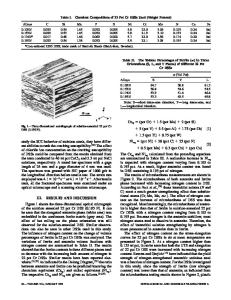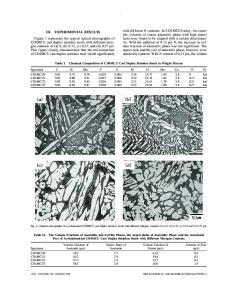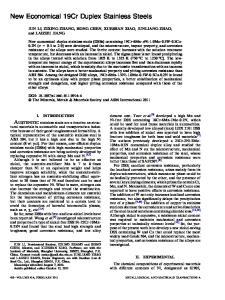Effect of Aging on the Fracture Behavior of Lean Duplex Stainless Steels
- PDF / 592,402 Bytes
- 6 Pages / 593.972 x 792 pts Page_size
- 25 Downloads / 306 Views
RODUCTION
IN conventional duplex stainless steels (DSS), the alloying elements are balanced to obtain a microstructure composed of about 50 pct austenite and 50 pct ferrite. In this way, the corrosion and mechanical properties of the materials are optimized.[1] Recently, however, several investigations have been carried out with the aim of producing low nickel and molybdenum DSS, also called lean DSS, since these elements are becoming quite expensive.[2–4] In order to balance the microstructure, manganese and nitrogen are added. In most cases, the corrosion resistance of lean DSS is lower than that of conventional DSS.[5,6] As far as mechanical properties are concerned, both yield and tensile strength increase as the concentrations of manganese and nitrogen are increased, whereas the impact fracture toughness decreases.[2,5] This effect has been attributed to the increase in the yield strength of ferrite, which favors the early occurrence of the local stress conditions required for brittle fracture. Conventional DSS show a large decrease in corrosion resistance and fracture toughness after aging between 300 °C and 1000 °C due to the precipitation of intermetallic phases, such as carbides (M23C6), nitrides (CrN and Cr2N), and the sigma (r) and chi (v) phases, depending on the temperature and time.[7–11] In particular, the presence of the v and r phases is very G. STRAFFELINI, Associate Professor, is with the Department of Materials Engineering and Industrial Technologies, University of Trento, 38100, Trento, Italy. Contact e-mail: giovanni.straffelini@ ing.unitn.it S. BALDO, Postdoctoral Student, I. CALLIARI, Researcher, and E. RAMOUS, Professor, are with the Department of Innovation in Mechanics and Managment, University of Padova, 35131, Padova, Italy. Manuscript submitted March 16, 2009. Article published online August 25, 2009 2616—VOLUME 40A, NOVEMBER 2009
undesirable, since they strongly promote localized corrosion and also display brittle fracture behavior. The low molybdenum content in lean DSS significantly reduces the precipitation of the deleterious v and r phases, and some investigations have been carried out to understand the corrosion behavior of lean DSS after solution annealing and also after exposure to high temperatures.[4,12] In the present study, instrumented impact testing is used to investigate the influence of aging on the impact fracture behavior of two lean DSS in order to the evaluate the possible benefits gained by the lack of precipitation of the v and r phases.
II.
MATERIALS AND TESTING
In Table I, the nominal chemical compositions of the two lean DSS under study are given. The samples for investigation were machined from hot-rolled bars with a diameter of 30 mm. The bars were previously solution annealed at 1050 °C for 30 minutes and then water quenched. The samples were submitted to different aging treatments at four temperatures (550 °C, 650 °C, 750 °C, and 850 °C) for 5, 45, 90, and 120 minutes. The volume fractions of austenite and ferrite in the solution-annealed samples and in the ag
Data Loading...











